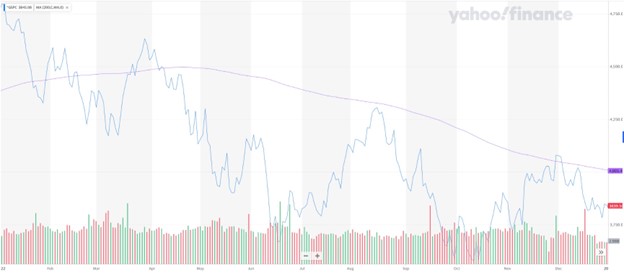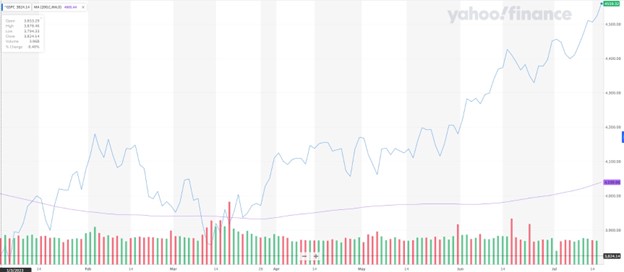There are some important lessons that I want to share now while they are still fresh in my mind, states Steve Reitmeister of Reitmeister Total Return.
Namely about when to switch from bearish to bullish (and vice versa). So, let's jump right into that timely topic in the commentary below...
Market Commentary
Market timing has become much harder. There is simply less adhesion to the trends of the past given the growth of computer-based trading versus decisions made by people on the fundamentals displayed through a prism of emotions (fear & greed).
The problems of market timing do not end there. Unfortunately, fundamentals are not foolproof either. As an economics major, I begrudgingly admit that it’s a soft science...as in not very exact. That is why you can get five economists together to review the data and come out with five different opinions of what comes next. More specifically to the most recent events...the bear market unfolded in 2022 because of the historical relationship between high inflation so often bringing on the next recession. Then an odd thing happened. No recession unfolded.
As we look in the rearview mirror it is much easier to understand why. That being two-four million baby boomers selecting early retirement in the face of Covid. This paved the way a for historic low unemployment rate that would not crack even 17 months after the Fed started raising rates. It is for these reasons that many professionals will NOT attempt market timing no matter how dark the storm clouds appear. They bet that future economic events are simply unknown and unknowable.
Once again, I begrudgingly have to admit that to be true more often than not. However, I cannot just stand in front of a freight train taking losses if and when a bear market unfolds. Gladly, as I honestly review my investing lessons learned going back to 1980 I do see a more reliable market timing approach. Many who follow my writing will not believe what is about to come out of my keyboard...but here it is.
Price action is a much more reliable means of market timing than fundamentals. In particular, a focus on the 200-day moving average (AKA the long-term trend line). When you boil it down, it is wise to be bullish above 200-day day for the S&P 500. And to be bearish under that mark. Let’s now review some charts to prove the point starting with the onset of the 2022 bear market:

Some people may argue what designates a true break below. Like how many sessions closed below the mark it truly takes to signal more ominous things to come. But even if an investor got bearish on the first break below this level in January 2022 around 4,400, they would have been well served as stocks descended another 20% to the lows of October.
Plus, you can see how many times the market tried to break above the 200-day and failed. Meaning that investors were well served staying bearish as long as the overall market was below the 200-day day moving average.
Now let’s move on to the 2023 picture:

Here too we see a breakout above in early January 2023 just below 4,000. Investors getting more bullish on that note have seen an ample rise up to a 52-week week high at 4,555 on July 18. Yes, there were some scary moments in March when there was a rash of banking failures that got stocks below the line for a short while. Yet by early April that was a distant memory before going on an extended bull run.
I am not going to show every period in history to prove my point. But rest assured I have put my own thought process under a microscope. Putting all ego aside I realized that when I chose my view of fundamentals over the 200-day day moving average...I was on the wrong side of history. In the most recent example, I moved from a bearish hedge to a 50% long portfolio to start April when the market was about 2% above the 200-day moving average. This came in the form of using our coveted Top 10 Small Cap screens that lived up to the billing with a strong period of outperformance.
This 50% invested in stocks approach was better than some investors who clung to the bearish narrative. Yet in retrospect I would have been better served to move to 100% by mid-April thereafter given the time and distance the market moved above the 200-day day trend line. This is especially true in our case with such a tremendous advantage on our side with the stock selection prowess of the POWR Ratings. In fact, the data scientist who helped me created the model has been trading a version of it since 2014. His data CLEARLY shows that staying invested with the best POWR Ratings stocks is a wise decision.
Back to the 200-day day moving average. The merit of this technical signal is hard to admit for someone with an economics background. But then I remembered some behavioral finance study that Mohamed El-Erian discussed a few years back. The original theory was that investors predicted events four-six months in advance. That is why stores typically dumped before bad economic events happened and seemed to rise during the darkest hour before the data improved.
Interestingly, some of the more recent research shows that it may not be that investors are so clairvoyant. Rather the positive or negative vibes from the stock price trends had a resounding effect on the economy. At first, this notion sounds crazy. But let’s remember that the vast majority of wealth in this country is in the hands of the top 10% who own 90% of the assets. No doubt a lot of that money is in the stock market.
Now consider that these same folks are the captains of industry. So, when their portfolios take a hit...they see their net worth go down...which leads to more cautious personal and business spending...which slows the economy. Here we rely on seeing how price precedes economic activity. On the flip, side we have a soaring stock market amidst a weak economic outlook. The net worth of these same wealthy people is on the rise...which lifts their mood. As they become less cautious and more optimistic, they start to spend more...thus improving economic conditions...thus showing the wisdom of the rising stock prices.
Long story short, price action is another valuable leading economic indicator. This only increases the value of using the 200-day day moving average as a key lever in when to be cautious (under days day) or more aggressive with stocks (over days day).
The employment picture 200-day day gives us the best clues when we may need to get more defensive. Until we see cracks in that armor, then we will continue to have a bullish portfolio posture.
Learn More About Reitmeister Total Return here…




















